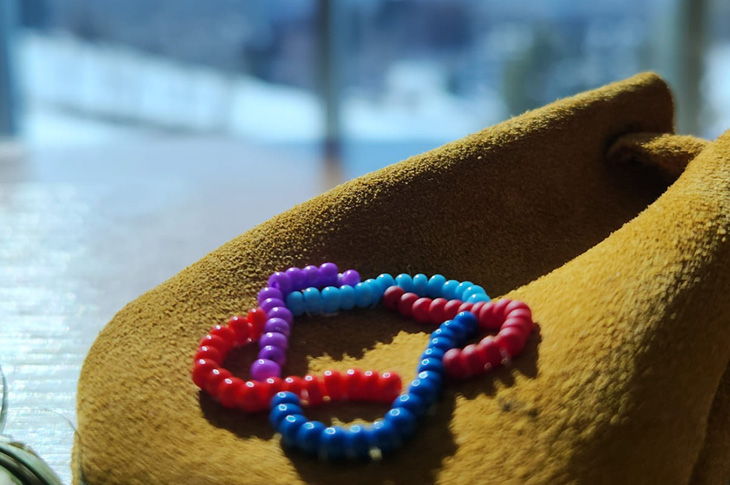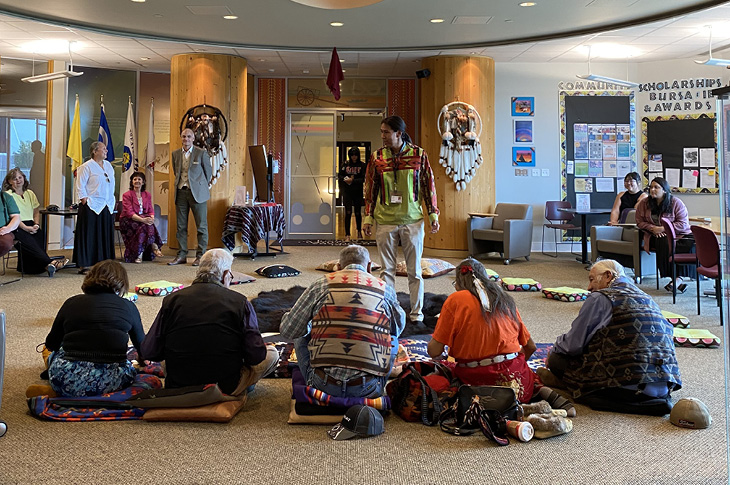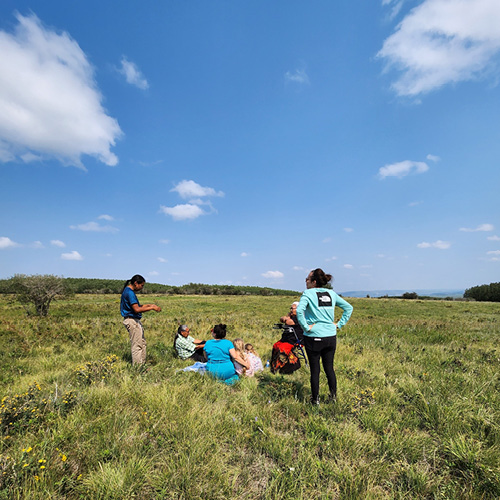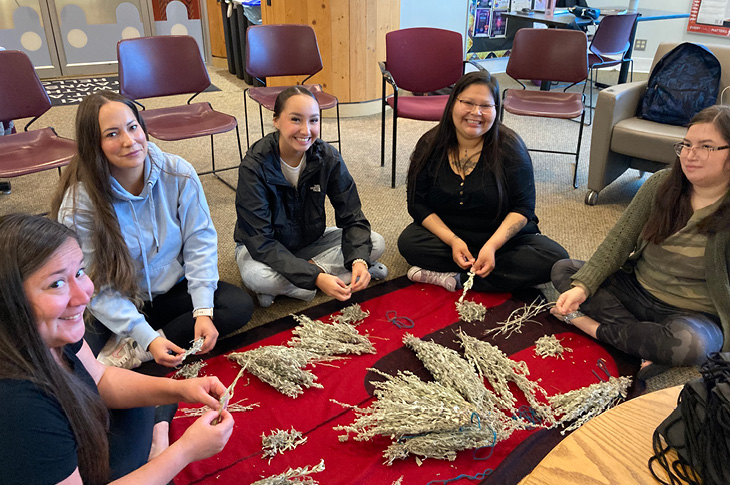SAIT’s Indigenous resource centre receives new name and Knowledge Keeper

Changes honour the rich tapestry of Indigenous heritage and support Truth and Reconciliation on campus
As the fall equinox approaches, Indigenous communities are giving thanks for the harvest and honouring the sun in traditional ceremonies before preparations begin for the coming winter. The opportunity to celebrate connection to the earth is a fitting time to re-introduce SAIT’s Indigenous student space on campus and unveil the new name — Natoysopoyiis (nah-toy so-poh-yees), which means holy wind lodge in the language of the Blackfoot people.
Steve Kootenay-Jobin, Manager, Indigenous Student Supports identified an opportunity to realign the support centre with Treaty 7 peoples and languages as an acknowledgement and tribute to the first stewards of our land. Many SAIT students from these Indigenous communities pass through the space — formerly called Chinook Lodge — during their journey through higher education.
“With the new name, our students will see themselves reflected to an even greater degree within the institution, and have a space with a name that strengthens the Indigenous world view of the education experience,” says Kootenay-Jobin.
View this post on Instagram
Jennifer Russell, SAIT’s Indigenous Engagement Director, and Kootenay-Jobin met with Elder Miiksika'am, Clarence Wolf Leg, of Siksika Nation — a member and recognized spiritual leader of the Blackfoot Confederacy — to begin the process of renaming the Lodge. Elder Miiksika'am gifted SAIT and Chinook Lodge with the name Natoysopoyiis during a pipe ceremony and painted the faces of Russell and Kootenay-Jobin as keepers of the Lodge.

“Being a lodge keeper is a profound honour and responsibility. Natoysopoyiis is a sacred place that has been available to thousands of people over 22 years,” says Russell. “My home away from home was made real for me when Miiksika'am painted my face and gave the Lodge its new name.”
Elders and Pipe Carriers from Treaty 7 communities participated and shared a feast following the ceremony, as a customary traditional practice.
“We have a responsibility to care for those who have made the journey and to celebrate them for joining us in ceremony and sharing what we could. Especially in the fall when we not only feed our guests in the physical world, but the ancestors in the spirit world,” says Kootenay-Jobin.
When sharing the meaning of the new name, Elder Miiksika'am described it as the wind carrying a sudden wet snowstorm which blankets the ground bringing moisture for the earth and life below. “This wind teaches us to prepare for unexpected weather change — like in life and unforeseen circumstances.”
Keeper of knowledge and ceremony
Those who attended the Lodge renaming ceremony had the opportunity to witness SAIT’s new Indigenous Knowledge Keeper, Thomas Snow, at work offering ceremonial knowledge and supporting the cultural protocols.
A Knowledge Keeper refers to someone who has been taught by an Elder or a senior Knowledge Keeper within their community. This person holds traditional knowledge and teachings, they have been taught how to care for these teachings and when it is and is not appropriate to share this knowledge with others.
“My Îyethka name is Wathu Wida meaning Hail Island. That is the name passed onto me by Lazarus Wesley (Wathu Wida’s youngest brother), who gifted me the name at a Îyethka Nakoda community naming ceremony. I carry on the name of my adopted grandfather, Wathu Wida (Paul Wesley), and it guides me forward in my life and connects me to my ancestors and community,” shares Snow.
Growing up in Mînî Thnî, formerly known as Morley, Snow was raised primarily speaking Îyethka, or Stoney Nakoda Sioux. His grandparents, Hunji gen (Alice Kaquitts Sr.) and Iyejen Mani (Thomas Simeon), were ceremonialist and his father Tatagagan (Tom Snow) apprenticed under Hunji gen. His mother Yumotata mani (Alice Kaquitts) was raised traditionally and immersed in ceremony. Snow has dedicated his life to carrying on the customs and practices of his ancestors while passing on the teachings and growing as a leader in a humble way.
“It's a deep understanding that comes from a lifetime of practice. It's something complex and at its essence is a search for truth and greater meaning in life. I've had the privilege of growing up around those Elders and community members who sought that learning and mentored me in my community.”

When he saw that SAIT was looking for an Indigenous Knowledge Keeper, Snow’s initial reaction was that the job would be perfect for his Elders. It was when he looked further he realized the position aligned closely with a lot of his current work. Looking to his Elder for guidance, Snow was reminded that this knowledge has been taught to him to carry on the important work through his passion, intelligence and youthful spirit.
An Îyethka phrase comes to his mind. “Eh mâgi hnâ gabich — meaning I have been given this responsibility to honour, uphold and share our teachings. All the knowledge, ceremonial practices, history and culture of our people. To share these in a good way that brings honour to our communities.”
Teaching wellness through traditional plants and medicines
Natoysopoyiis serves as a safe space for Indigenous students at SAIT to express and reflect their identities, culture and spirituality while on their educational journey. The Lodge is a place for students to connect to the land and ceremony by accessing supplies needed to care for their mental, emotional and spiritual health.
Part of Snow’s role as Indigenous Knowledge Keeper is to share teachings and foster the connection between SAIT’s campus community and Indigenous culture. In early September, he planned a day for the Natoysopoyiis team to harvest traditional medicines needed at the Lodge for the year. According to Indigenous beliefs, you can’t purchase medicine and the outing would allow them to make proper offerings and have the medicine blessed, while spending time together connecting with the land.
“All of these pieces together set the intention of why we were picking so that intention carries through and is felt by the students using the medicines. To gather strength and cleanse themselves of the negative emotions and anxieties and to ground them through this process,” says Snow.
Along the foothills of the Rocky Mountains, the day began with an offering to the Tatanga (buffalo) near the collection site and an acknowledgement of the relationship between the sacred animals and the medicine which was about to be harvested. A ceremony was held and the Elder guiding the group shared teachings about the medicines before they spent time collecting from the land.

“People think that the medicine itself is the most important thing, but in truth, it's all of it working together. The medicine draws from the Âba (sun), the Mâkochî (earth), the Mînî (water) and the Ganuthza (wind). You’re not just harvesting the plant itself, but everything that's gone into it.”

Oki, Âba wathtech, Danit'ada, Tawnshi, Hello.
SAIT is located on the traditional territories of the Niitsitapi (Blackfoot) and the people of Treaty 7 which includes the Siksika, the Piikani, the Kainai, the Tsuut’ina and the Îyârhe Nakoda of Bearspaw, Chiniki and Goodstoney.
We are situated in an area the Blackfoot tribes traditionally called Moh’kinsstis, where the Bow River meets the Elbow River. We now call it the city of Calgary, which is also home to the Métis Nation of Alberta.